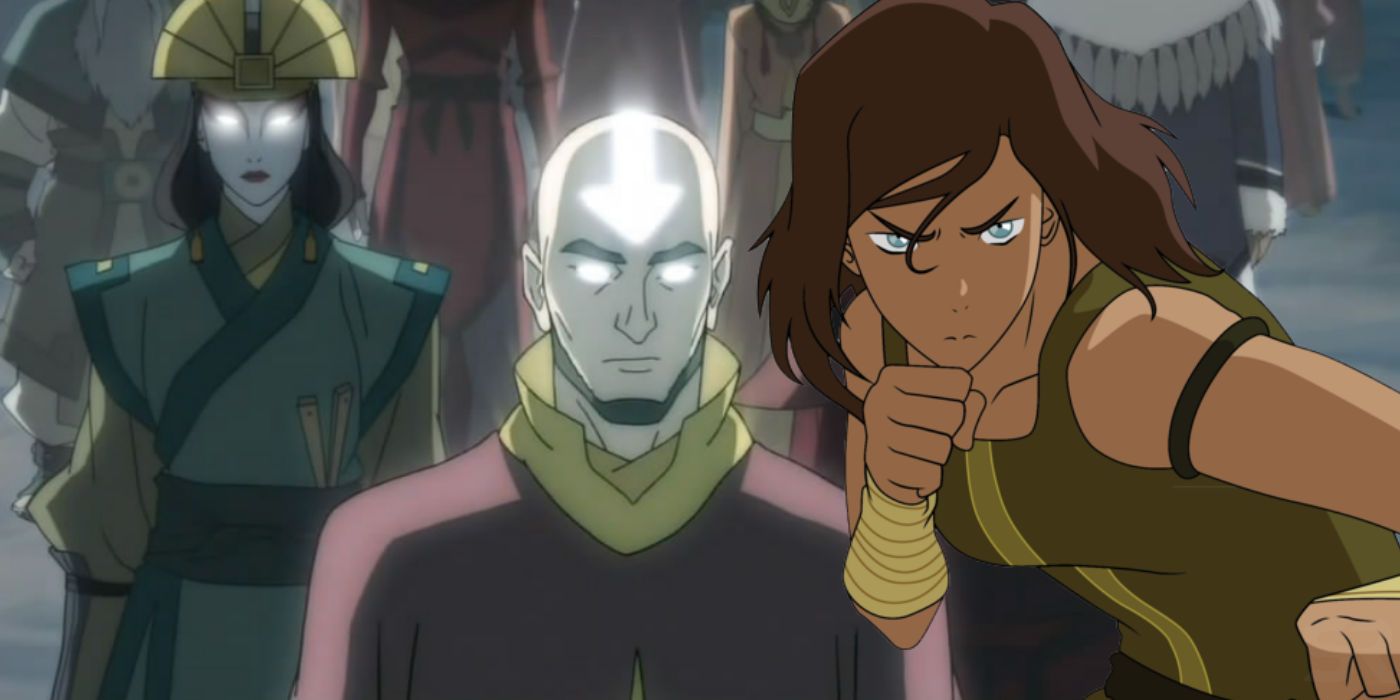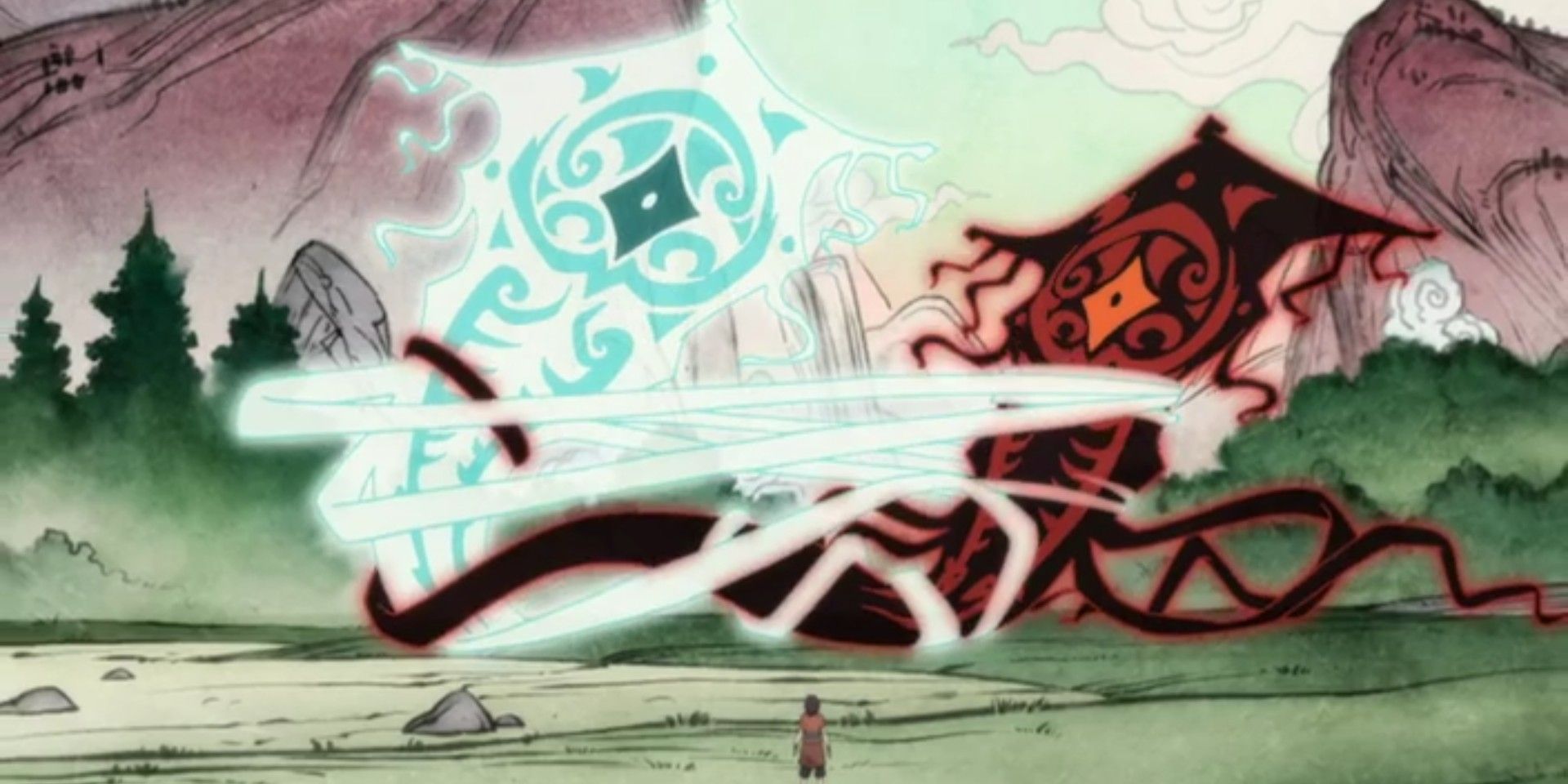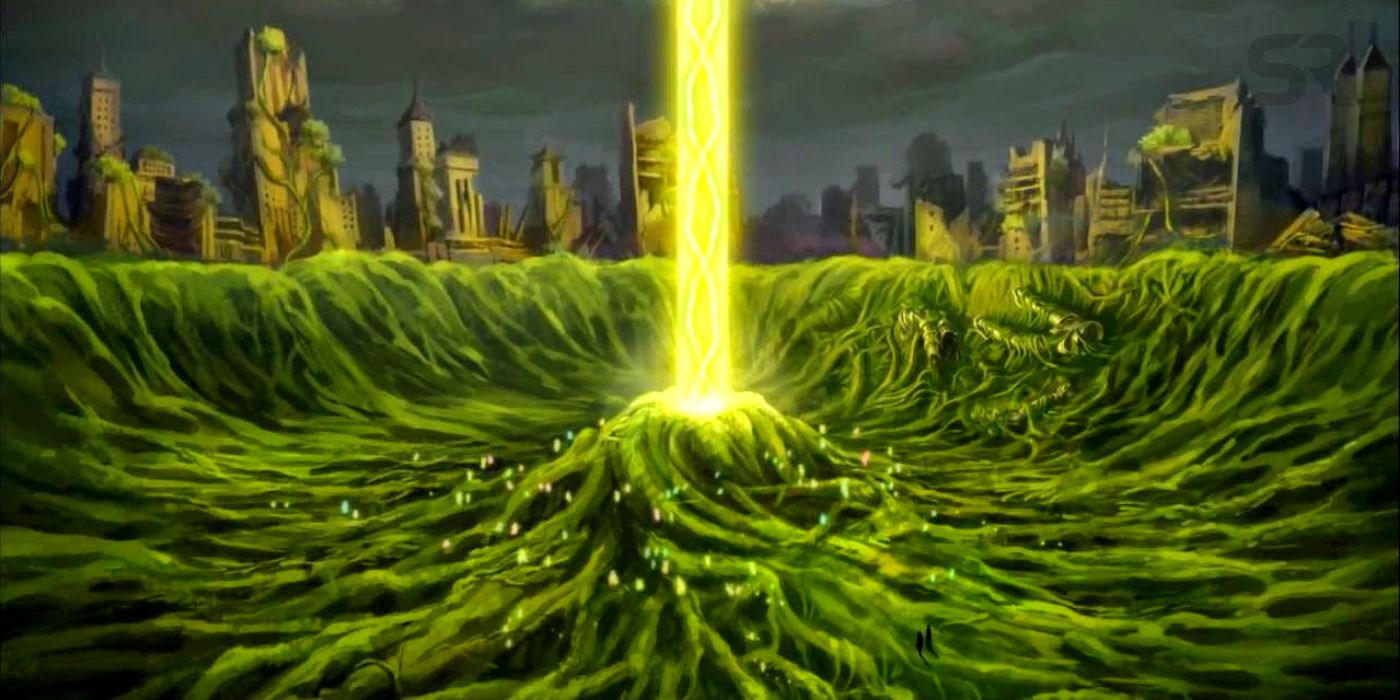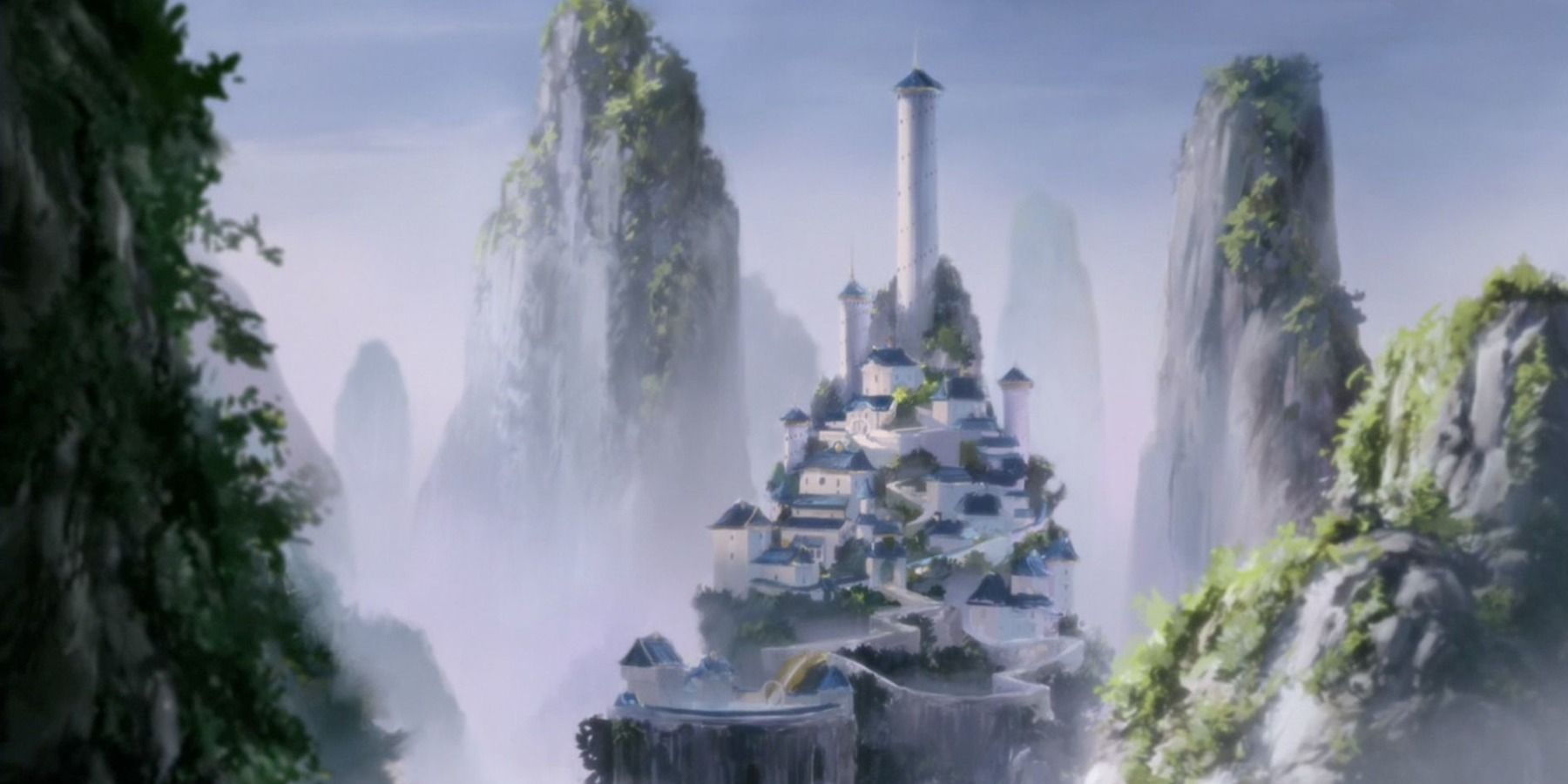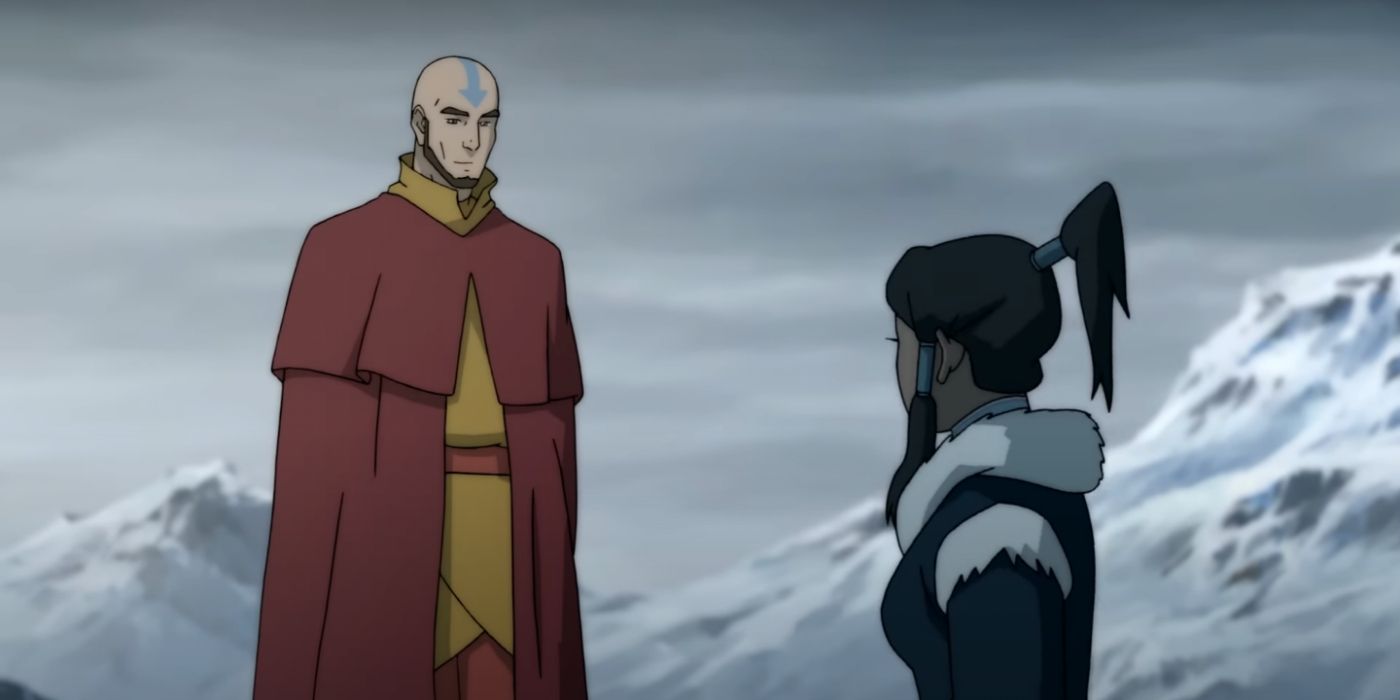The Legend of Korra season 2 is one of the most polarizing parts of the entire Avatar mythos, due largely to the tragic moment when Korra's Avatar connection was lost. In the final battle against Unalaq and Vaatu, the great light spirit Raava is torn out of Korra and brutally beaten into oblivion. While Korra is able to resuscitate Raava by the season’s end, her connection to the past Avatars is permanently severed. However, there are a few reasons why this was inevitable, and in fact, necessary. In a rough season, Korra losing her connection to previous Avatars has been notably singled out by critics of Legend of Korra, despite it having thematic significance.
Some fans blamed Korra for losing her connection, which doesn’t make sense given the circumstances under which it is, literally, beaten out of her. Still, the loss of Korra's Avatar connection is a powerful and understandably sad moment in Legend of Korra. While a tragic moment, Korra losing her connection with her past lives is not only inevitable but essential to her journey. Moreover, it’s a pivotal moment for the show’s overall message. The show is about trauma and change – about how endings become beginnings, and new growth comes from the destruction of the old. Beyond this thematic tie-in, the end of season 2 makes sense from a narrative standpoint, given the initial role of the Avatar between the physical world and the Spirit World.
The Era Of The Avatar Was Never Meant To Last Forever
In “Beginnings,” the two-part flashback that tells the story of the first Avatar, Wan, audiences see what the world looked like before the Avatar came to be. Spirits roamed the human world freely, thanks to the portals created by Vaatu at the North and South Poles. Because of this, humans were forced to take refuge on the backs of the Lion Turtles, where they built their cities. During this time, Raava and Vaatu were locked in a constant battle, keeping each other in balance until Harmonic Convergence. But, because of Wan’s interference, Vaatu escaped from Raava’s grip and grew in power.
During the final showdown between Wan, Raava, and Vaatu, right when the great spirit of darkness has his foes backed into a corner, he makes a bold claim — “the Era of Raava is over.” The thing is, even though he loses the battle, he’s right. The Era of Raava as it was known had ended, and the Era of the Avatar began. The portals were closed, and the spirits mostly retreated back to their world, leaving the humans to spread across the Earth.
Was this paradigm shift tragic? It isn’t painted as such in the show. The cohabitation of spirits and humans appears to only cause strife in “Beginnings,” and Raava continues to live on within the Avatar. But a closer inspection shows that the change isn’t all good. Suddenly free to spread, conquer, and cultivate the Earth, humans engage in a series of brutal wars, devastating much of the natural world and killing untold numbers. Wan dies in despair on a battlefield, believing he failed in his quest to bring balance. Over time, the spiritual division causes innumerable problems for future Avatars going forward.
That doesn’t mean Wan made a mistake. It simply means all these must end, and beget new things. The Legend of Korra makes it clear balance is a constant effort, not a status that can simply be attained. Balance in Wan’s day meant closing the portals, while the balance in Korra’s day meant opening them up. During Korra’s own battle with Vaatu, where her past lives are ripped from her, Unalaq makes his bold claim — “the Era of the Avatar is over.” And though he ultimately loses the battle, he’s also right - sort of.
The Avatar Is No Longer Needed As The “Bridge” After Opening The Portals
From the earliest episodes of Avatar: The Last Airbender, the Avatar is primarily defined as “the Bridge between the Two Worlds,” meaning the physical and spirit worlds. That entire role ceases to exist when Korra reopens the Northern and Southern Portals and eventually creates a third portal in Republic City. The fusion of Wan and Raava was meant to maintain balance in an era when the physical and spiritual realms were separated. With the realms reunited, doesn’t that mean the “Bridge” is no longer needed? Yes, and no.
While Korra's Avatar connection's purpose changes, the Avatar remains - just as Raava remained when she ceased to be an all-powerful physical presence and bonded with a human. Korra can still enter the Avatar State, bend all four elements, and help facilitate peaceful coexistence between humans and spirits. In this way, Korra is the start of a new cycle – the first in a new incarnation of Avatars, whose world and role will be vastly different from what came before. Wan’s story isn’t just told in season 2 to set up a villain, it’s told to parallel the journey Korra must inevitably embark on.
Just as things were lost and sacrificed in the interest of balance when the Era of Raava ended, so must things be lost and sacrificed when the old Era of the Avatar ends. Is that necessity more symbolic than literal? Yes - and that’s a big reason why the loss of Korra's Avatar connection is so frustrating for so many fans. Avatar and Korra succeed at such a high narrative level, it’s difficult to grapple with the shows also largely being metaphorical and thematically driven.
Korra Is A Show About Trauma And Change
The fact is, The Legend of Korra is primarily a thematically-driven show, even more so than Avatar: The Last Airbender. Korra losing her connection to past Avatars suits this difference in tone. Aang’s journey has one arc, from start to finish with concrete, nuanced character growth, and a clear conflict. Legend of Korra — largely because of the way Nickelodeon ordered the series one season at a time - has less of a central narrative through-line. The core story of The Legend of Korra, more than anything, is the state of the modernizing world — specifically, the way that world is changing. "Change" and "Balance," the titles of the show’s third and fourth seasons, are two sides of the same coin.
The Legend of Korra spends an immense amount of time discussing the idea of how change is inherently traumatic, and how it is still necessary to reach balance. In season 3, Zaheer often quotes an old Airbender proverb about how “new growth cannot exist, without first, the destruction of the old.” It’s a mantra for the whole show. The global humanitarian efforts of the Airbenders in season 4 might never have happened if the Fire Nation’s horrific acts of genocide had not been committed.
Does that mean the murder of thousands of Airbenders was a good thing? Of course not. It simply means all things yield new things, whether good or bad. This idea is a challenging one, but it’s one The Legend of Korra insists on centering. It’s also central to much of the real-world spiritual philosophy that inspired the entire world of Avatar. In Buddhism, the concept of impermanence in all things is a central tenet. It's, in fact, the first of Buddhism’s "three marks of existence", which are seen as fundamental to all things.
Still, saying that Korra's Avatar connection and the loss of her connection to her past lives was necessary because Buddhism holds that all things are impermanent might not be a satisfying explanation for everyone, which is understandable. In the scope of the story, it’s a heartbreaking moment. Talking about how the second of the three marks of existence is suffering likely wouldn’t help either. But to fully understand all the controversial changes The Legend of Korra makes, audiences need to understand that it’s a show about change. One of the Avatar’s defining traits is reincarnation. When her past lives were severed, Korra was still reborn.
How Korra Can Still Communicate With Past Avatars
Despite the loss of Korra's Avatar connection, that does not mean that she can't still communicate with past Avatars. It seemed that Korra's connection to the Avatar State was ruined beyond repair, but the story wasn't finished. Korra had a lot of hardships to face, and she still had a chance to use the Avatars there to help guide her along the way. Korra should still be able to contact her past lives when needed. It almost seemed like it would never happen though, since when Raava was destroyed, all the past Avatars disappeared to her. However, if Korra's story continues there's a way she can still communicate with past Avatars even though her connection is severed.
Korra's connection to the past Avatars was what was destroyed — not the spirits of the past Avatars themselves. This means that it could still be possible for Korra to communicate with past Avatars like Aang. The show revealed , the former Avatars resided in the Spirit World, and their existence beyond death had nothing to do with Raava. As Iroh showed, an individual spirit can persist in the Spirit World, even when Korra's connection to her Avatar was severed. The world of Avatar shows that the spirits are never completely gone, making The Legend of Korra ending more open-ended than believed. If Korra can find a way to convene with beings in the Spirit World then the wisdom of former Avatars is still open to her..

